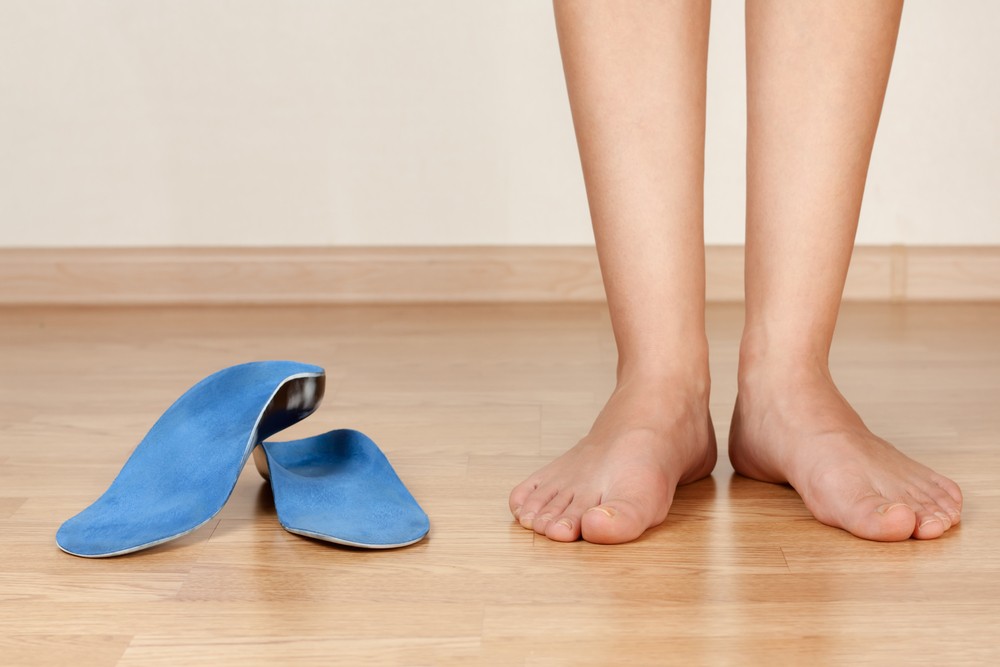
The use of foot orthotics — also referred to as custom insoles/inserts/footbeds — is an effective way to give your feet added support. Orthotics offer a number of benefits to people with certain foot problems. So how do you know if you need orthotics? Read our blog to find out.
Pronators
Pronated feet is a common issue. Pronation is a fancy word to describe feet with falling arches where the ankles roll inward. Sometimes people think of this as having ‘flat feet.’ It can be complicated to treat pronated feet because there can be many factors contributing to the problem. Common issues include muscle weakness or imbalance, ankle instability, or previous injury.
Whatever the reason, pronated feet will cause a misalignment between the ankle and the foot, which may also lead to misalignments in the knees, hips, pelvis and back. This can cause possible long-term damage to the ligaments and joints. Orthotics benefit people with pronated feet because it gives them the protection, support and motion control that they’re missing by distributing force and pressure through the foot in a different way.
It can take a while for people with pronated feet to show painful symptoms. We often hear people saying, “I’ve had flat feet all my life, why did they just start hurting last Tuesday?” If you have pronated feet, we recommend that you address the problem proactively by getting a professional examination before symptoms start.
Supinators
While problems with pronated feet often occur later in life, issues with supinated feet can show up earlier. Supinated feet have a very high arch and cause the foot to roll outwards. It is often associated with tightness in the calf muscles and hamstrings. Both foot shape and muscular tightness can lead to a lack of shock absorption in the foot. People with supinated feet tend to place extra pressure on the heel and the ball of the foot which can become sites of pain. As a result, this foot type can lead to back pain and injuries like achilles tendinitis, peroneal tendinitis, ankle sprains and iliotibial (IT) band syndrome.
Since supinated feet provide less flexibility and shock absorption, extra cushioning is required. Orthotics provide this extra cushioning as well as helping to redistribute pressure throughout your foot.
People With Diabetes
Proper footwear and foot orthotics are important for people with diabetes. Diabetes can lead to a general lack of sensation in your feet, so it’s important to start protecting them as soon as you’ve been diagnosed. Improper foot care can cause major complications for people with diabetes. Being properly fitted for the correct footwear and orthotics is essential for preventing infections and avoiding the risk of amputation.
Arthritis
All forms of arthritis can cause foot pain, including rheumatoid arthritis (RA), osteoarthritis (OA) and psoriatic arthritis (PA). Inflammation is a major part of rheumatoid arthritis and leads to foot complications like hammertoes and bunions. Osteoarthritis is a joint specific form of arthritis, often thought of as the ‘wear-and-tear’ form of arthritis. It can affect any of the joints in the foot. Psoriatic arthritis typically causes inflammation in the small joints of the toes.
By redistributing the weight and relieving pressure on sensitive areas of the feet, orthotics can be a great option for reducing pain and even slowing down the damage caused by these forms of arthritis. Orthotics provide cushioning to reduce stress on the lower body, as well as correcting gait and structural abnormalities.
CMT (Charcot-Marie-Tooth Disease)
Charcot-Marie-Tooth Disease is a nervous disorder affecting the peripheral nerves. It usually starts in the feet, causing weakness and numbness. This disease is inherited and symptoms usually start to appear before the patient is 20 years old. Since CMT causes foot deformities (such as high arched feet), foot drop, loss of muscle and numbness, orthotics can be used to help those with CMT to walk properly, and to slow the development of other foot problems as well.
In addition to orthotics, people with CMT, diabetes, arthritis, or pronated and supinated feet will also require the right type of shoes for their orthotics and for their specific foot problems.
Before you choose your orthotics or shoes, it’s important to get a proper assessment so you have the right support. Come into one of our locations to find out what Walking Mobility Clinics can do for your case!

